Garmin Venu 2
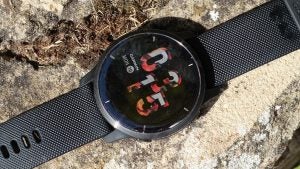

The Garmin Venu 2 is a great watch for those who don’t need the hardcore performance monitoring of Garmin’s top watches. It leaves out some of the stats intended for athletes, but the less bulky design and colorful touchscreen display make it more fun to use day-to-day.
Pros
- Good heart rate and GPS location tracking
- Battery life improved over last gen
- Bold smartwatch-like screen
Cons
- Lacks Forerunner and Fenix series performance metrics
- New VO2 Max style may not appeal to exercise fanatics
Availability
- UKRRP: £349.99
- USARRP: $349.99
- EuropeRRP: €400
- CanadaRRP: CA$
- AustraliaRRP: AU$629
Introduction
Key Features
- Battery life: The endurance here is good
- Two sizes:The Venu 2 comes in 40mm and 45m sizes
- Sensors:GPS, Compass, Blood oxygen and more
The Garmin Venu 2 is a higher-end running and fitness watch with more of a smartwatch flavour than other Garmin devices.
It swaps the highly practical but quite dull-looking screens of the Fenix and Forerunner watches in favour of an OLED. You get more gloss and a touchscreen, rather than having to pilot the thing only with buttons. content
It’s a great watch for regular run tracking, the smartwatch basics, and has a very good heart rate sensor. However, some will still be better opting for the less glitzy Forerunner 745 instead. The Garmin Venu 2 doesn’t offer insights about training effect, recovery and training status.
I’ll look at what these actually mean in this review, but they’re handy if you want to use tech to see how your fitness progresses over the months.
If you’re not in this stat-obsessed crowd but are still more interested in exercise tracking than smartwatch apps, I’d recommend the Garmin Venu 2 over an Apple Watch 6 or Samsung Galaxy Watch 3. The battery life alone makes it one of the best smartwatches around.
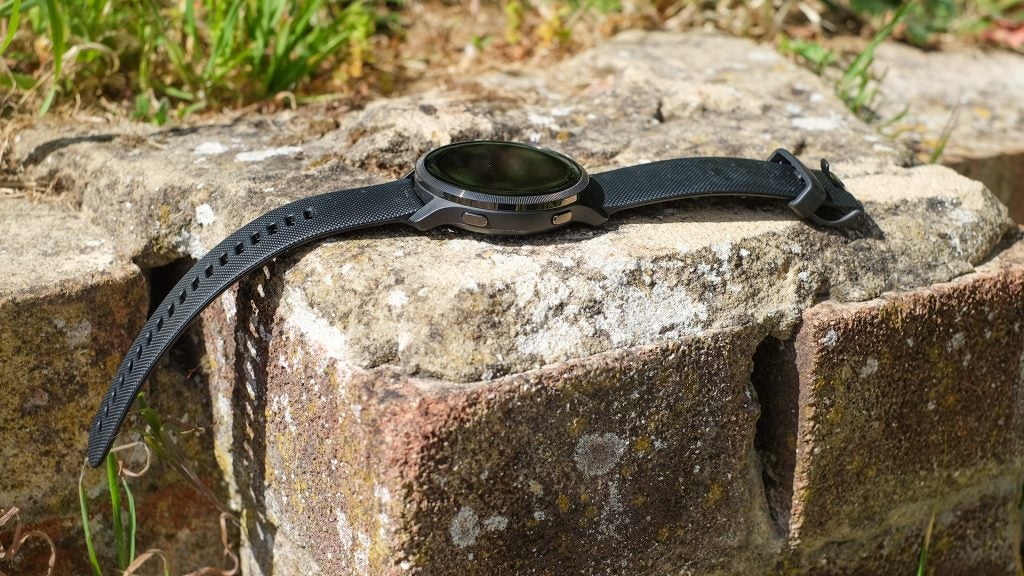
Design
- Available in two sizes
- 40mm or 45mm option
- Doesn’t have bags of style
The Garmin Venu 2 range comes in two sizes. What you see here is the standard version. It isn’t huge, nor is it tiny. It has a 45mm diameter – and if that seems too big, just buy the Venu 2S instead, which is 40mm wide. Both devices are priced identically.
The pair look more-or-less like smartwatches – and more like cheaper units such as the OnePlus Watch or Amazfit GTR 2e than the Samsung Galaxy Watch 3.
I don’t think anyone should come to Garmin’s higher-end watches expecting bags of style. You won’t find it. But the Garmin Venu 2 is pleasant enough.
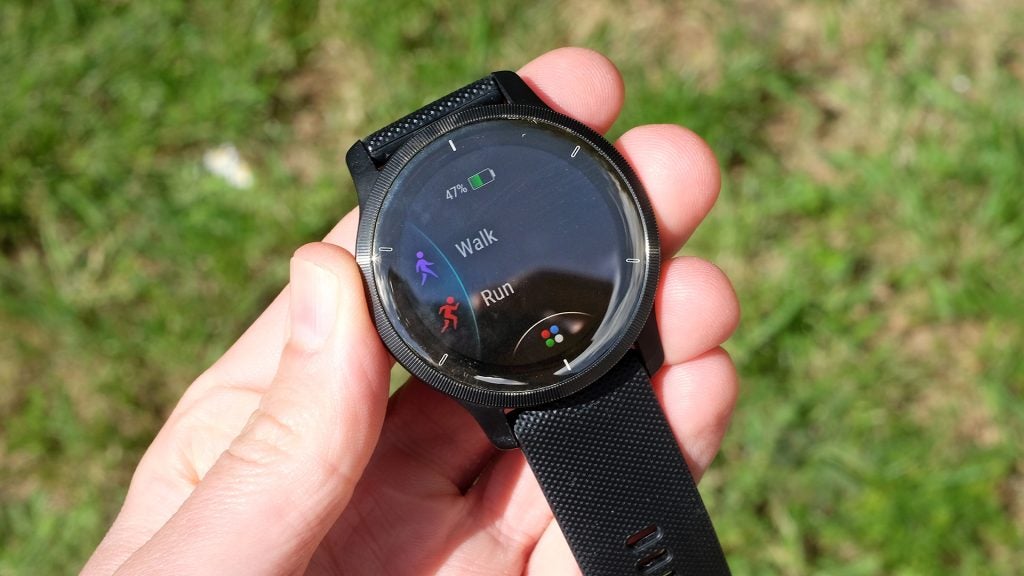
The top layer of the device is toughened glass, but not of the expensive Sapphire type. A ring of stainless still sits around the glass, only partially protecting the screen because its top lip sits just a fraction of a millimetre above the glass itself.
It’s clear here that Garmin’s intentions with the Venu 2 have been to make a ‘lifestyle’ watch, not a chunky, ultra-rugged device.
The Venu 2’s underside is plastic and the strap a functional-not-fancy silicone. A bunch of Chinese companies such as Huawei, Honor, Amazfit and Oppo pump out watches of similar contraction at around a third of the price. Again, you don’t buy a Garmin for style. You buy it for what it can do.
I like the Venu 2 for all-day wear far more than the Garmin Fenix 6 Solar. It feels far less weightier on your wrist as you run, and it’s just about light and petite enough to wear for sleep tracking without a sense you’re turning into a Mark Zuckerberg-adjacent tech acolyte.
Screen and battery life
- OLED display
- 416 x 416, 1.3-inch screen
- Always on mode
An OLED screen defines the Venu 2’s place in the wider Garmin range. The majority of Garmin watches have a transflective screen, one that becomes brighter and clearer the more ambient light there is.
This is perfect for exercise outdoors, and ‘stays on’ 24/7 while using very little battery power. However, such screens are relatively low-resolution and their colour and contrast aren’t very strong. The Venu 2’s OLED offers far greater image pop, bringing the same sort of gloss you get with an Apple Watch.
The 45mm Venu 2 I have features a 416 x 416-pixel, 1.3-inch screen. Compare that to the 240 x 240-pixel Forerunner 745 and you start to see the appeal. The Venu 2 screen looks shaper, which does wonders for the stacks of graphs you can view on the watch itself. More on that later.
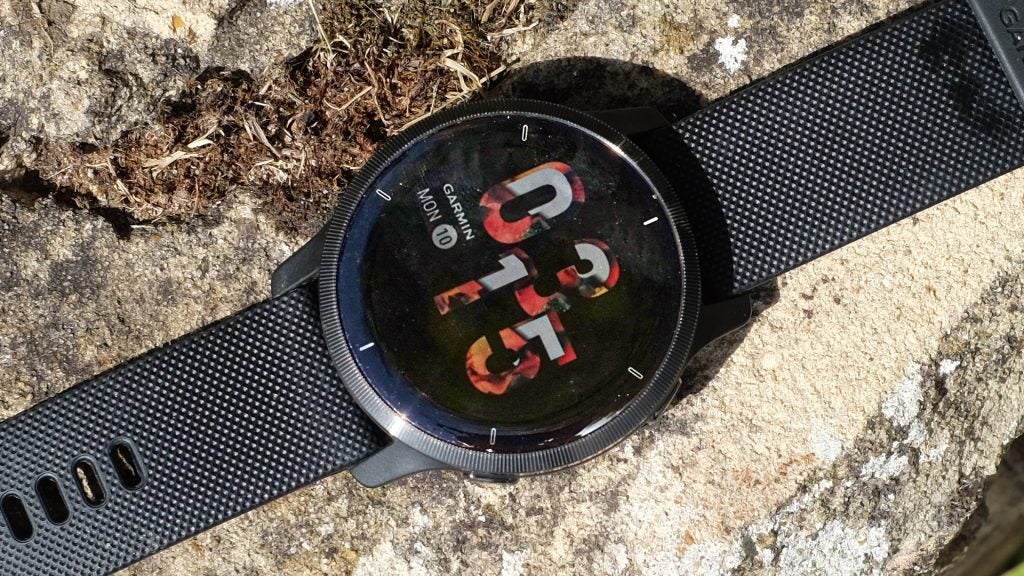
As standard, the Venu 2 screen doesn’t stay on all the time. You simply whip the watch around to your face to make it light up, as is the case with most other OLED watches.
However, dig around in the Settings menu and you’ll find options to keep the screen lit during exercise, and all day long. Obviously, this impacts battery life, and Garmin also warns the ‘always on’ mode may affect the lifespan of the screen. This likely refers to image retention and pixel degradation, notable OLED issues – but it’s too early to tell if Garmin is just being characteristically cautious. Always-on modes in OLED watches are very common, it probably is.
Keep the ‘always-on’ mode switched off and you’ll see battery life that comes close to Garmin’s claim of 11 days. Following six days the charge level had dropped from 100% to 38%. I hadn’t worn it 24/7, but I had used the Venu 2 for two hours of GPS tracking.
Checking the battery level before and after these tracked workouts, Garmin’s claim of 20-hour GPS battery life also seems sound. It loses 5-6% an hour.
The Venu 2 lasts far longer than the original Venu, which is rated at just five days. It has the same 20-hour GPS stamina, suggesting there’s significant power optimisation in the processor, software or display. Or all three.
Unfortunately, the full-on always-on display mode has a huge effect on longevity. It loses a couple of per cent charge each hour, draining a full charge in a couple of days. After 24 hours with the screen lit whenever worn, the Venu 2’s battery dropped from 61% to 16%.
I love watches that display the time, all the time. I don’t love watches you need to charge every other day. And where I’d normally suggest using ‘always on’ where it halves battery life, the sacrifice is probably too great here.
Always-on during exercise? Yes. Always-on 24/7? No – consider keeping it off.
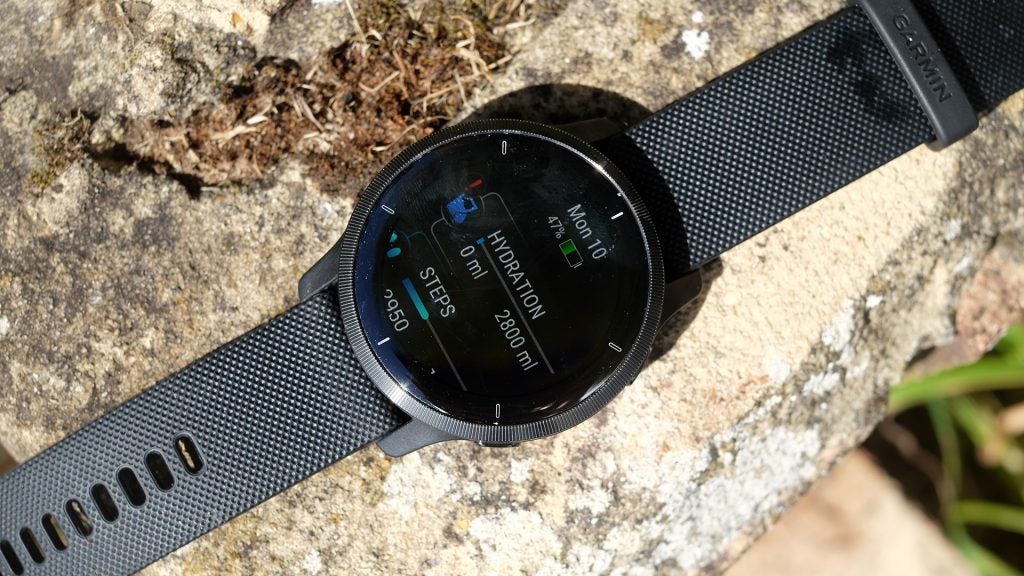
There are also three levels of brightness control available in Settings. However, I don’t think most will need to worry about these since the Venu 2 features an auto-brightness sensor that increases display power when you go outdoors, or into a brighter environment.
This is classic Garmin: if it can give you a customisation option, it will.
Health and fitness tracking
- A focus on generalised health tracking
- Plenty of tracking options
- Works with Garmin Connect app
It’s easy to start reeling off lists of features when talking about Garmin watches, but the character of this watch is fairly easy to explain. The Garmin Venu 2 is a little closer to the Fitbit Sense than most other Garmin devices.
There’s a greater focus on generalised health tracking than your fitness progress. It estimates how stressed you are, your breathing rate and your ‘body battery’ – a Garmin stat intended to look at how rundown you might be.
But you don’t see a performance indicator when you go for a run, something that pops-up mid-workout in Forerunner watches. Or your training load, which analyses how much you’ve exercised in the past week relative to your usual routine. Or any suggestions of how long you should rest after each session before taking on the next.
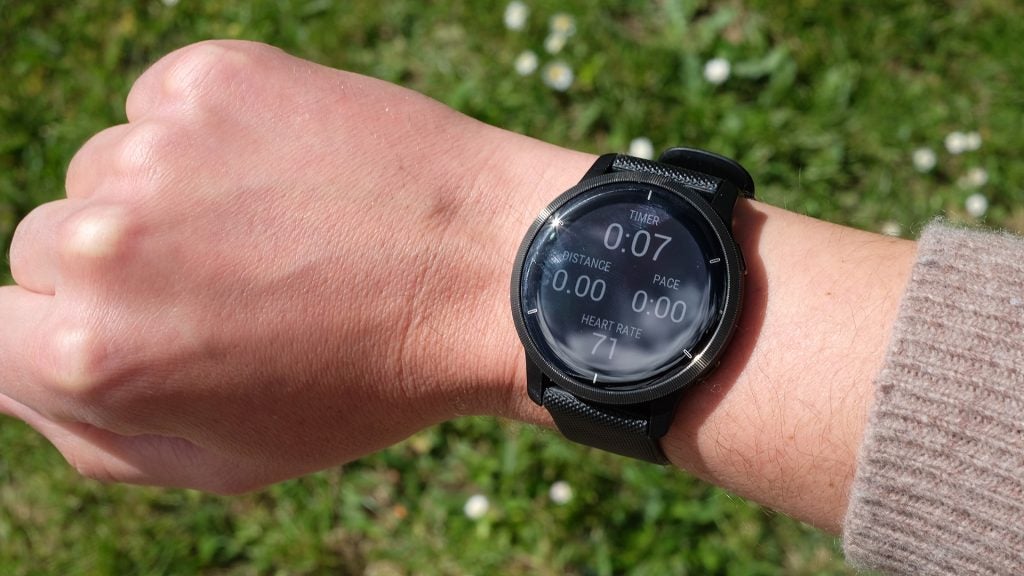
The Garmin Venu 2 hasn’t updated my VO2 Max score, either. There’s no sign of it on the watch anywhere, although it does support the stat. A little digging suggests that this is because the watch uses a new way to judge VO2 Max, relying on your ‘fitness age’, calculated using stats such as your BMI and resting heart rate, rather than your performance during exercise.
The message I get is the Venu 2 is tailored for people who exercise a bit less often, or at least less hard, than the average Garmin Fenix/Forerunner owner. That seems sensible, but as someone who uses a Garmin 90% for run tracking, I prefer the classic Garmin VO2 Max calculation.
You see this lighter approach in the interface, too. The main interaction in the Garmin Venu 2, outside of tracked exercise, is the Glances screen. Flick up or down from the watch face and you’ll see a long list of tracker stats.
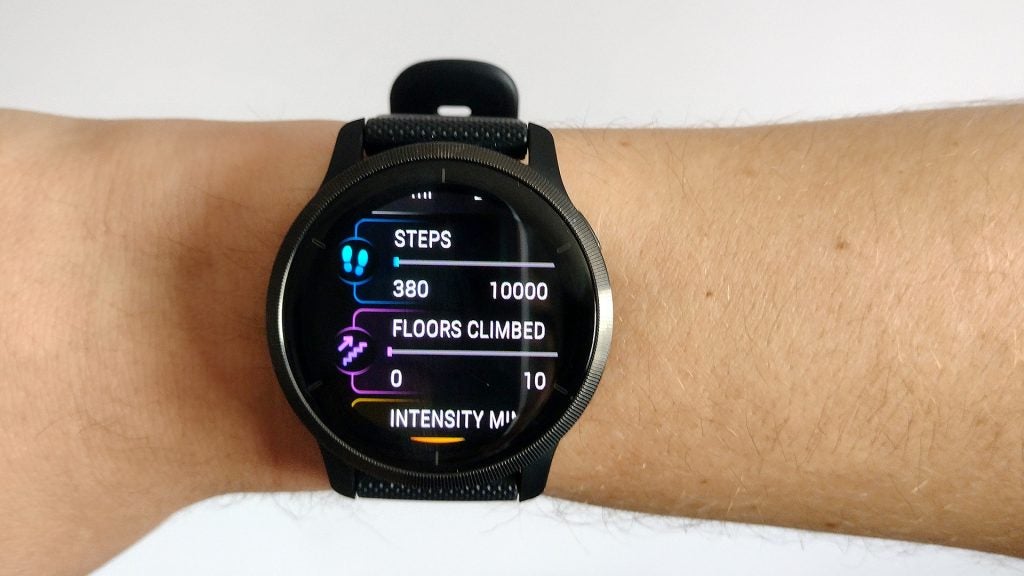
You choose what goes in here, but the default is the following:
- Steps
- Floors Climbed
- Intensity Minutes (per week)
- Calories
- Hydration
- Heart Rate
- Body Battery
- Stress
- Respiration (breathing rate)
- Pulse Ox (blood oxygenation)
- Sleep
- Activities (recent workouts)
- This week (summary)
- Schedule
- Notifications
- Weather
- Health snapshot
Combine this array with the lack of nerdy performance metrics and you realise the Venu 2 is less of a flat-out runner/marathon/triathlon watch than other Garmins around the price.
You can dig pretty deep into these lighter areas of fitness tracking, mind. Tap on a ‘Glance’ stat and you’ll see a detailed scrollable graph of results from the past (roughly) 24 hours. And, in some cases, charts showing a history of results over the past week when you flick down to the next screen.
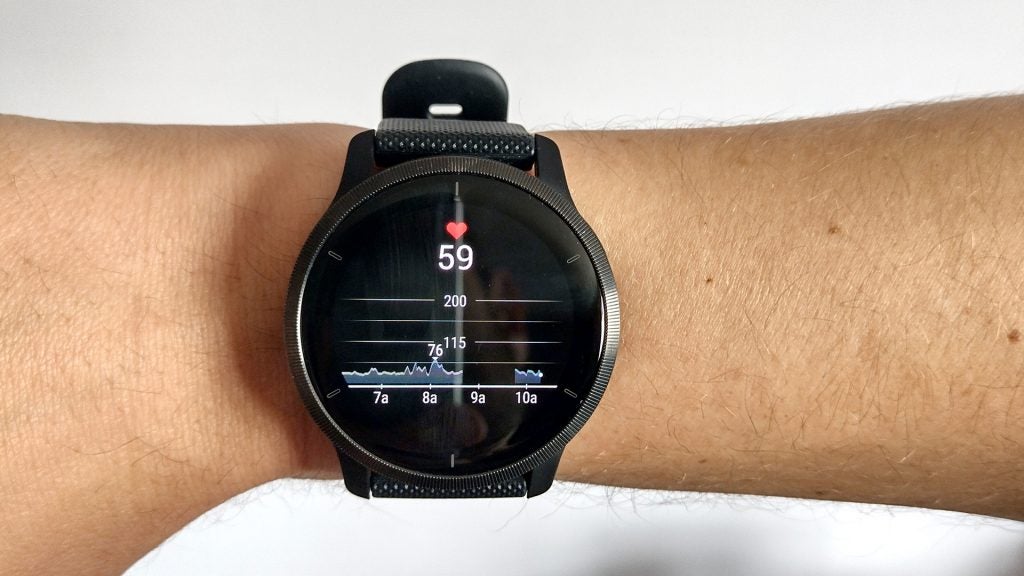
I think this sort of data is best looked at on the Garmin Connect app, but it displays Garmin’s nerdy love of stats, and browsing through it all feels responsive and natural enough on the small touchscreen. This watch doesn’t feel slow and doesn’t – unlike some longer-lasting OLED watches – use an obviously low display refresh rate to conserve battery.
A lack of hardcore performance metric doesn’t mean the Venu 2 is necessarily the wrong choice for those who run marathons. Its GPS accuracy is very good, and I see great results from the new heart rate sensor.
The Garmin Venu 2 has an Elevate v4 heart rate sensor. It uses two LEDs and four light sensors, up from two in the last-generation array.
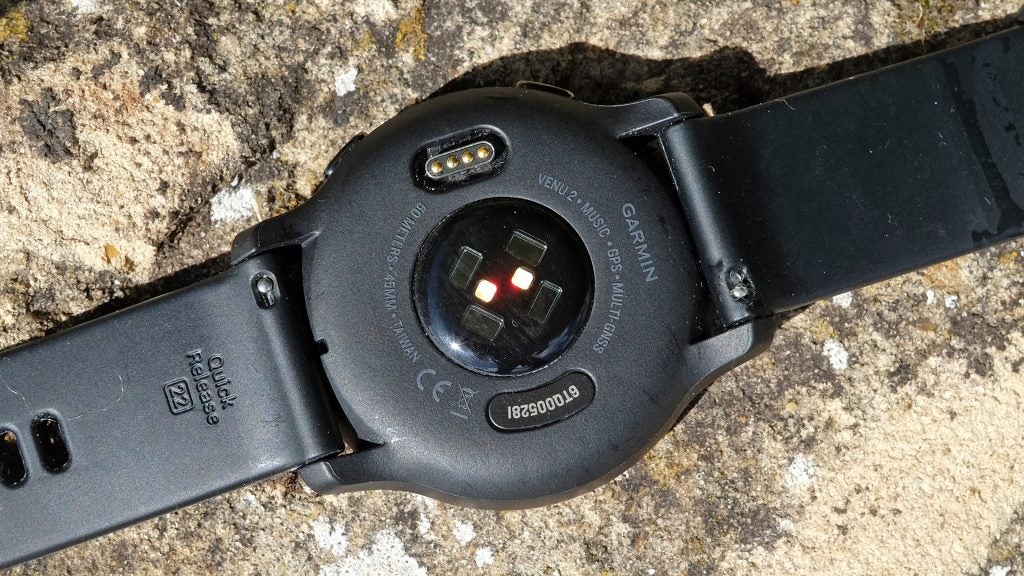
I compared the Venu 2’s results with those of a heart rate chest strap during a run. The results were extremely similar. The peak recorded heart rate was at the same moment, with just a 1bpm difference in the recorded rate. Peaks and troughs mapped onto each other very well.
There was one anomaly. Before the workout started properly, the Venu 2’s reading dropped to around 65bpm when it should have been ~80bpm, despite recording a more accurate reading at the very start of tracking.
It’s important to remember the software is just as important as the hardware when it comes to heart rate tracking. For example, I had more issues with the Garmin Fenix 6 Pro Solar than this back in 2020. It would usually report a too-high heart rate at the start of tracking, an issue that seems to have largely disappeared after subsequent software updates.
I think the Garmin Venu 2 is a great tracker for runners, as long as you don’t use stats such as training load and per-workout performance indicators to spur you on.
However, bear in mind the Venu 2 lacks proper maps. This is no surprise.
The more fitness-forward Garmins around the price, such as the Instinct and Forerunner 745, don’t have proper mapping either. It’s an expensive feature in Garmin land.
Not convinced yet? Garmin goes far further than most with its on-watch workouts. These are available in several of the Venu 2’s 25 tracking modes, which range from walking to yoga and bouldering.
For example, choose a workout in yoga and you’ll see animated guides on the different poses. Strength training offers similar prompts.
Each of these workouts splits the sessions into blocks, a little like having a personal trainer who doesn’t shout at you.
Muscle maps are a new Venu 2 feature. You’ll see these before you start each strength-based workout. They show the muscle groups used.
A bunch of guided workouts are pre-loaded on the Venu 2, and you can add more through the Garmin Connect app on your phone. I rarely use them, but it’s a nice free feature, and you can create your own from scratch.
Sleep tracking
- Good sleep tracking features
- On par with Fitbit models we have reviewed
The Garmin Venu 2 has slightly more advanced sleep tracking on offer than other Garmin watches. Looking further into the results, it seems to be based on using indicators such as breathing rate, stress and Pulse Ox (blood oxygenation, tracked if enabled) to inform the results.
However, stress and breathing rate are both derived from heart rate variability. It’s Garmin dressing up stats that its other watches already harvest.
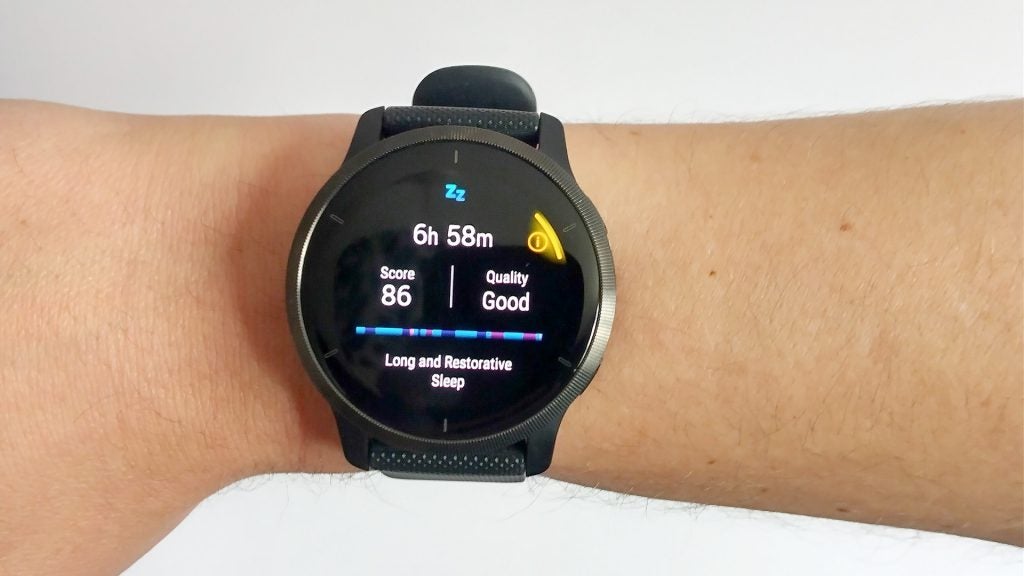
I don’t have a lot of faith in the accuracy of wrist-worn sleep trackers, but the Venu 2 seems solid enough, now roughly on a par with Fitbit’s sleep tracking style.
It registered when I woke up briefly at 2am one night, and when I hit snooze on an alarm one morning and went back to sleep for an additional 20 minutes.
Smart features and apps
- A limited selection
- Apps for Spotify, Amazon Music and Deezer
- Space foe 650 songs
Music is another Garmin Venu 2 highlight. Its a standard feature across the Venu 2 and Venu 2S, and there are apps for Amazon Music, Spotify and Deezer.
The Spotify app lets you download playlists and browse ‘recently played’ albums if you’re not an organised Spotify-er, but you don’t get full browse access to the Spotify library. It would be a bit of a nightmare anyway, since the Venu 2 isn’t designed to let you type away on the screen itself.
You connect Bluetooth headphones to listen, and there’s space for around 650 songs on the watch, or a little over 6GB.
Not a streaming service fan? You can take the old-school approach by transferring tracks using Garmin Express on your Mac or Windows computer. Music controls are available during workouts, as you’d hope.
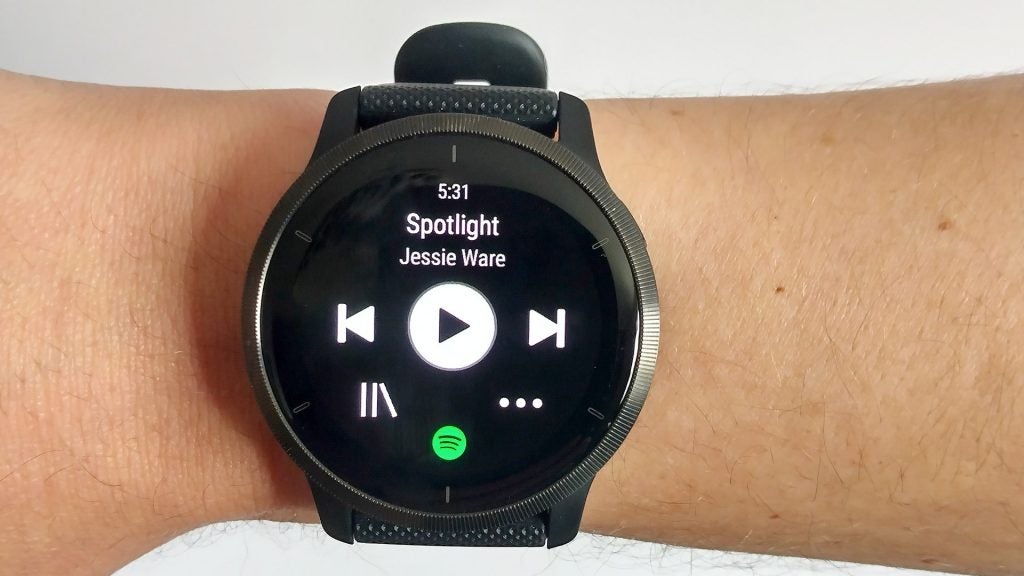
The Garmin Venu 2 is also the first watch to support Connect IQ 4.0, the latest version of Garmin’s app platform.
This effectively means developers can now create apps with graphics suited to the higher-resolution OLED displays of watches from the Venu series. It doesn’t mean you suddenly get access to a whole new world of software.
A browse through Connect IQ is much like doing so on any other higher-end Garmin watch. You can download lots of watch faces, stacks of data screens. But this isn’t like the Apple Watch library.
Useful features you can add are tools to find your car in the car park, Pomodoro work timers and alerts for intermittent fasting fans.
Don’t expect too much and you won’t be disappointed. That said, the Venu 2 does have much of what I use a smartwatch for. It offers wireless payment via Garmin Pay (check to see if your bank is supported), music playback and notifications.
You can receive your WhatsApp messages, or alerts from any app, on the Venu 2. And you can also send canned replies, which you compose beforehand in the Garmin Connect app.
Conclusion
I have loved using the Garmin Venu 2. I trust its stats, it’s fairly comfortable to wear 24/7, and the battery life is good as long as you don’t set the screen to stay on all day. Just don’t buy a Venu 2 expecting a high-end Forerunner watch with an OLED screen. While it records the usual dizzying array of metrics, some of the stats that can help you balance a packed workout schedule are left out.
Best Offers
Best Offer content
Should you buy it?
You want a glossy Garmin
Take a mid-range Garmin runners’ watch, rip out the (to some) stale-looking transflective screen and add a bold OLED and you get the Garmin Venu 2, more or less. While I’m a fan of Garmin’s other display style, this one is sure sharper, bolder and more colourful.
You want to balance a stacked workout regime
The Venu 2 lacks some of the metrics that the most ardent Garmin fans enjoy, such as training load, suggested recovery times and training effect. I’ve grown to love these, and they’re useful if you like to analyse how you work out, not just how much you can lift or how fast you run a kilometre. They aren’t necessary, but can be beneficial.
Verdict
The Garmin Venu 2 is a great watch for those who don’t need the hardcore performance monitoring of Garmin’s top watches. It leaves out some of the stats intended for athletes, but the less bulky design and colorful touchscreen display makes it fun to use day-to-day.
FAQs
The Venu 2 has full GPS, meaning you don’t need to take a phone with you for full location tracking.
The Venu 2 connects to your phone over Bluetooth but also has Wi-Fi for data uploads.
The Venu 2 has 5ATM water-resistance and a couple of swim-tracking modes, so is well equipped for swimmers.
The post Garmin Venu 2 appeared first on Trusted Reviews.
Source Trusted Reviews ,Home Appliances Reviews

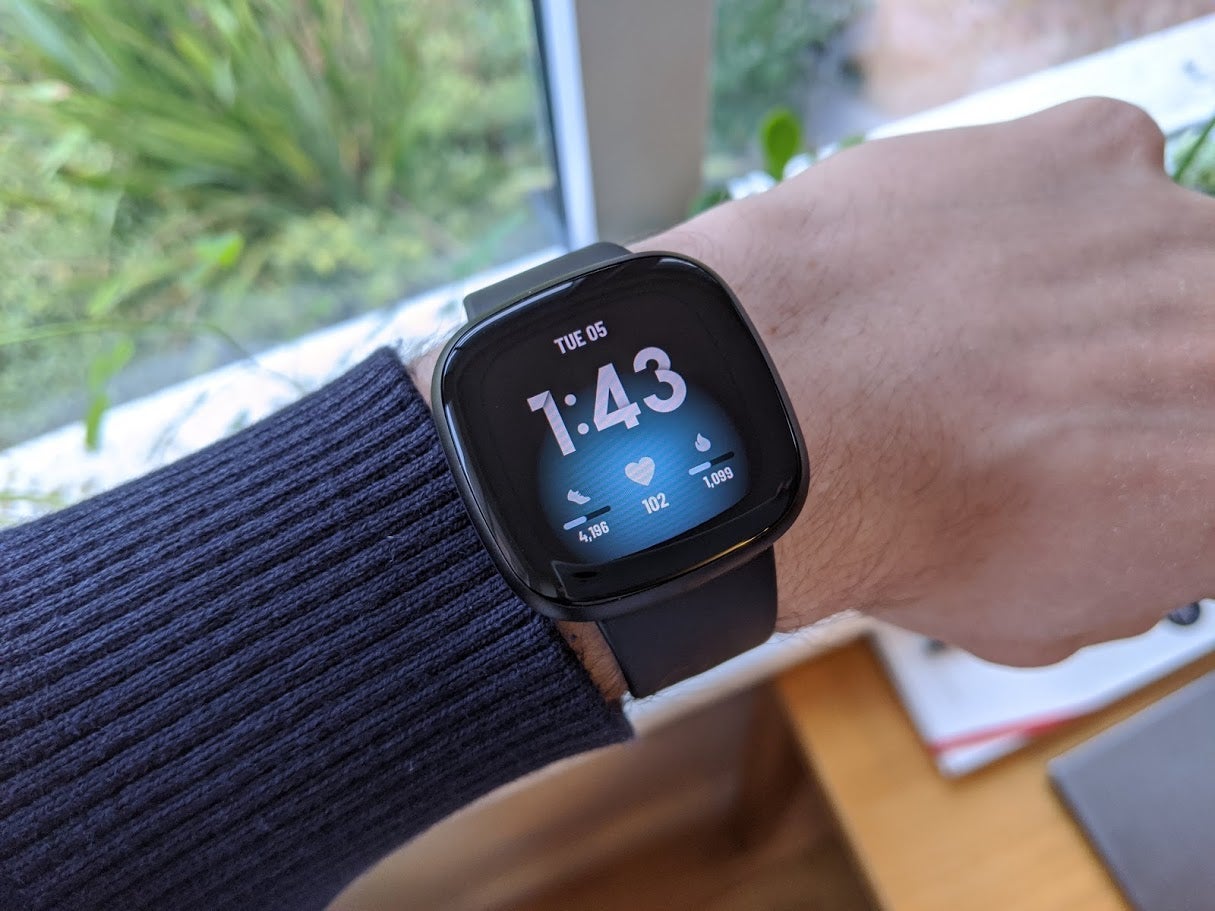
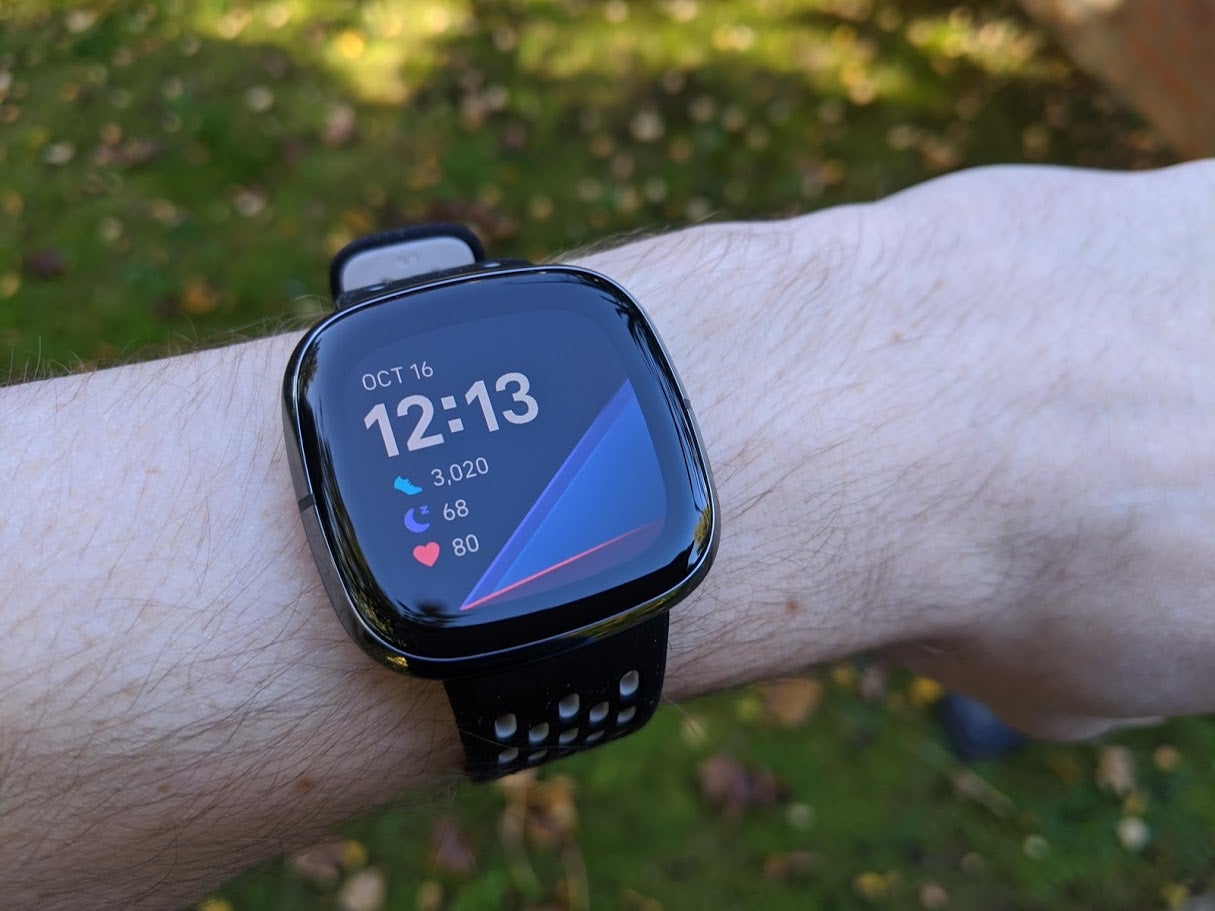
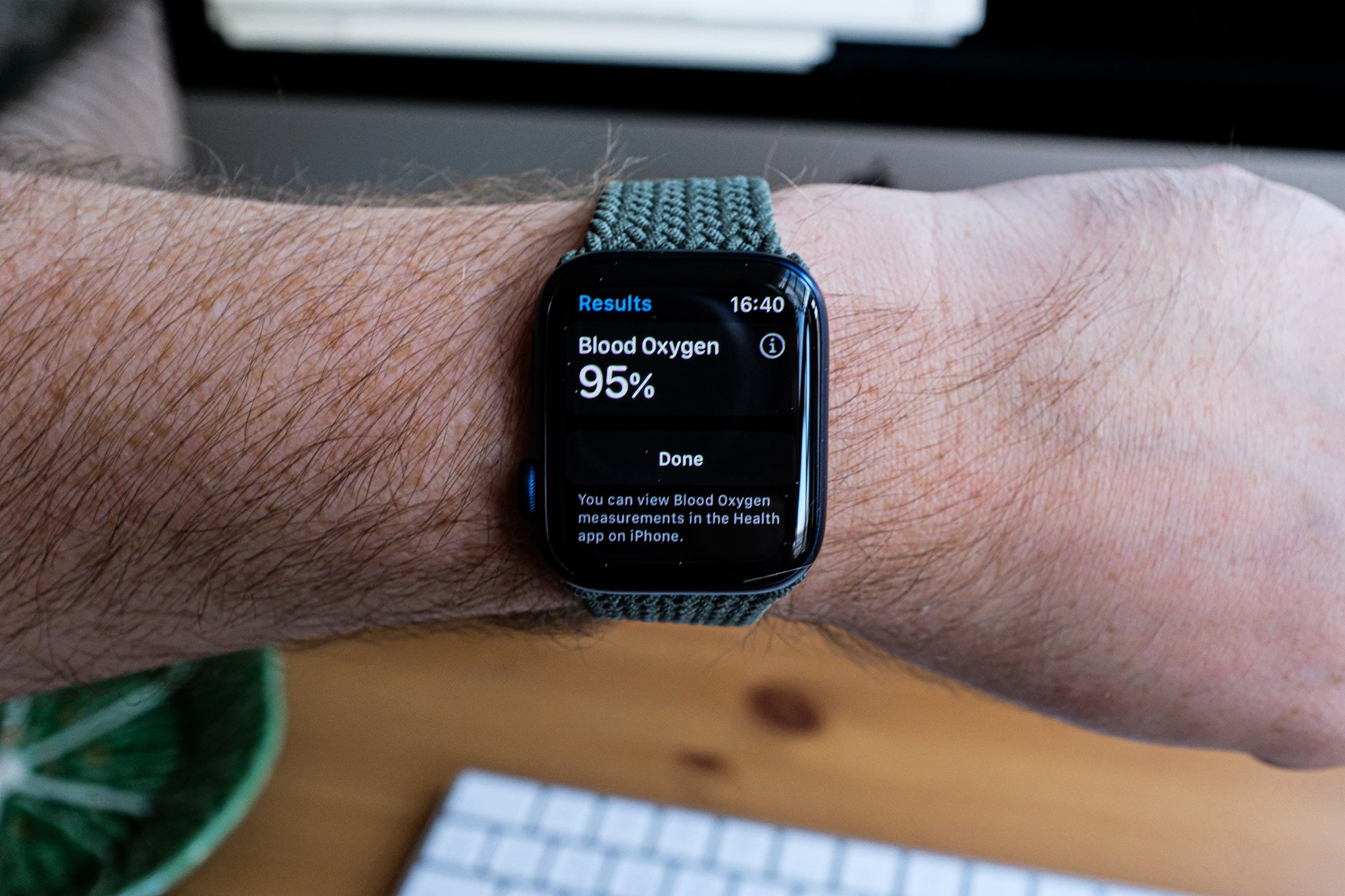
No comments